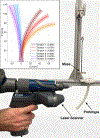Encoding Desired Deformation Profiles in Endoscope-Like Soft Robots
- PMID: 40963645
- PMCID: PMC12440119
- DOI: 10.1109/tmrb.2024.3503894
Encoding Desired Deformation Profiles in Endoscope-Like Soft Robots
Abstract
Prior models of continuously flexible robots typically assume uniform stiffness, and in this paper we relax this assumption. Geometrically varying stiffness profiles provide additional design freedom to influence the motions and workspaces of continuum robots. These results are timely, because with recent rapid advancements in multimaterial additive manufacturing techniques, it is now straightforward to create more complex stiffness profiles in robots. The key insight of this paper is to project forces and moments applied to the robot onto its center of stiffness (i.e. the Young's modulus-weighted center of each cross section). We show how the center of stiffness can be thought of as analogous to a "precurved backbone" in a robot with uniform stiffness. This analogy enables a large body of prior work in Cosserat Rod modeling of such robots to be applied directly to those with stiffness variations. We experimentally validate this approach using multimaterial, soft, tendon-actuated robots. Lastly, to illustrate how these results can be used in practice, we investigate how stiffness variation can improve performance in a neurosurgical task.
Figures









References
-
- Burgner-Kahrs J, Rucker DC, and Choset H, “Continuum Robots for Medical Applications: A Survey,” IEEE transactions on robotics, vol. 31, no. 6, pp. 1261–1280, 2015.
-
- Mangels DR, Giri J, Hirshfeld J, and Wilensky RL, “Robotic-assisted percutaneous coronary intervention,” Catheterization and cardiovascular interventions, vol. 90, no. 6, pp. 948–955, 2017. - PubMed
-
- Jiang S, Lou J, Yang Z, Dai J, and Yu Y, “Design, analysis and control of a novel tendon-driven magnetic resonance-guided robotic system for minimally invasive breast surgery,” Proceedings of the Institution of Mechanical Engineers. Part H, Journal of engineering in medicine, vol. 229, no. 9, pp. 652–669, 2015. - PubMed
-
- Yang Z, Zhao B, Bo L, Zhu X, and Xu K, “CurviPicker: a continuum robot for pick-and-place tasks,” Assembly automation, vol. 39, no. 3, pp. 410–421, 2019.
Grants and funding
LinkOut - more resources
Full Text Sources
